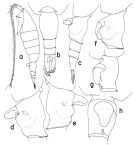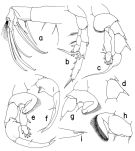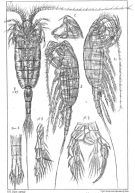|
|
 |
Fiche d'espèce de Copépode |
|
|
Calanoida ( Ordre ) |
|
|
|
Arietelloidea ( Superfamille ) |
|
|
|
Heterorhabdidae ( Famille ) |
|
|
|
Heterorhabdus ( Genre ) |
|
|
| |
Heterorhabdus norvegicus (Boeck, 1872) (F,M) | |
| | | | | | | Syn.: | Heterochaeta norvegica Boeck,1872; Giesbrecht, 1892 (p.373); Vanhöffen, 1897 a (p.281); Sars, 1900 (p.79, figs.F,M);
? Heterochaeta profunda F. Dahl, 1894;
? Heterorhabdus profundus : Giesbrecht & Schmeil, 1898 (p.115); no Wolfenden, 1905 a (p.12); Sars, 1907 a (p.18); no Gaudy, 1963 (p.26, figs.F,M, Rem.);
Heterorhabdus (Heterorhabdus) norvegicus : Vervoort, 1965, p.118, Rem.) | | | | Ref.: | | | Giesbrecht & Schmeil, 1898 (p.115); Sars, 1902 (1903) (p.118, figs.F,M); Farran, 1908 b (p.65); Sars, 1925 (p.226); Farran, 1926 (p.281, Rem.); Wilson, 1932 a (p.132, figs.F,M); Rose, 1933 a (p.202, figs.F,M); Jespersen, 1934 (p.106); 1940 (p.52, fig.7); Lysholm & al., 1945 (p.35); Sewell, 1947 (Rem.: p.175 & suiv.); Farran, 1948 e (n°16, p.3, fig.F); Brodsky, 1950 (1967) (p.349, figs.F,M); Grice & Hulsemann, 1965 (p.245, Rem.); Shih & al., 1971 (p.40, 204); Vidal, 1971 a (p.11, 22, 115, figs.F,M); Bradford, 1971 a (p.122, figs.F,M); Kos, 1976 (Vol. II, figs.F, M, Rem.); Lapernat, 1999 (p.19, 55); Bradford-Grieve & al., 1999 (p.883, 944, figs.F,M); Park, 2000 (p.139, figs.F,M, Rem.); G. Harding, 2004 (p.3, figs.F,M); Vives & Shmeleva, 2007 (p.302, figs.F,M, Rem.) |  issued from : T. Park in Bull. Scripps Inst. Oceanogr. Univ. California, San Diego, 2000, 31. [p.266, Fig.114]. Female: a, habitus (left side); b, c , urosome (dorsal, left, respectively); d, e, genital somite (left, right, respectively); f, genital somite with operculum closed (left, tilted clockwise, ventral, respectively). Nota: Prosome about 2.4 times length of urosome; posterolateral cornerbroadly rounded, overlapping anterior 1/10 length of genital somite. Dorsally genital somite widest about 1/3 length of somite from anterior end, typically with a length-width ratio 100 : 69, symmetrical with smoothly furved lateral swellings and gradually narrowing toward posterior end. Laterally, genital somite typically with a length-depth ratio 100 : 78. Dorsal wall sigmoid with a broadly rounded hump followed by a smooth shallow concavity. Genital prominence roundrd. Genital flange relatively high, smoothly rounded, followed by a lobular outgrowth, which is in turn followed by several concentric ridges. Posterior slope of lobular outgrowth extending linearly to posterior end of somite. Genital operculum reaching anterior edge of lobular outgrowth. Shape of genital flange remaining unchanged when genital operculum is open (Figs.114-d, e). Ventrally, genital operculum (Fig.114-h) asymmetrical, tapering posteriorly, typically with a length-width ratio 100 : 79 and 70% as wide as somite itself. Genital field with a cluster of about 40-50 small pores on each side. Urosome 30% length of body. Length ratios of 4 urosomal somites and left caudal ramus 38.9 : 18.0 : 13.2 : 8.4 : 21.5 = 100. Left caudal ramus extending beyond posterior end of right by about 1/7 its length (as measured along medial margin. Dorsal appendicular seta of left ramus about 1.5 times length of that of right ramus. A1 extending beyond posterior end of of caudal ramus by its 2 segments. Mx2: Posterior subterminal spine of 4th lobe 34% as long as 2nd saberlike spine; falcate spine of 5th lobe about 1.3 times length of saberlike spine, with proximal 58% of medial margin serrated with spinules; falcate spine of 6th lobe with proximal 67% of medial margin serrated with spinules.
|
 issued from : T. Park in Bull. Scripps Inst. Oceanogr. Univ. California, San Diego, 2000, 31. [p.267, Fig.115]. Female: a, left Mx2; b, P5 (posterior. Male: c, left P5 (anterior); d, second exopodal segment of left P5 (anterior); e, right P5 (anterior); f, exopod of right P5 (posterior); g, h, basipod of right P5 (anterior, posterior, respectively); i, distal end of exopod of right P5 (lateral). Nota: Prosome 71% length of body and about 2.4 times length of urosome.Urosome 30% length of body. Caudal rami and their setation as in female. Left genicular A1 similar in morphology to that of H. spinifrons. All other cephalosomal appendages and P1 to P4 as in female.
|
 issued from : G.O. Sars in An Account of the Crustacea of Norway. Vol. IV. Copepoda Calanoida. Published by the Bergen Museum, 1903. [Pl.LXXX]. Female & Male.
|
 Issued from : K.A. Brodskii in Calanoida of the Far Eastern Seas and Polar Basin of the USSR. Opred. Fauna SSSR, 1950, 35 (Israel Program for Scientific Translations, Jerusalem, 1967) [p.350, Fig.245]. Female (from central part Arctic): habitus (dorsal and lateral right side); R, rostrum; MRi, Md (biting edge, right side view); S1, P1; S5, P5. Male: S5, P5 (Le = left leg).
|
 Heterorhabdus norvegicus Heterorhabdus norvegicus female: 1 - See key to species groups of Heterorhabdus: ''abyssalis'' Group (p.90, 114). 2 - Genital somite without a conical projection mediodorsally (Fig.114-a, c). 3 - Ventrally, genital somie with a small conical process bearing concentric ridges posterior to genital operculum (Fig.114-g, h).
|
 Heterorhabdus norvegicus Heterorhabdus norvegicus male: 1 - See key to species groups of Heterorhabdus: ''abyssalis'' Group (p.90, 114). 2 - Basis of left P5 without a well-developed inner lobe (Fig.115-f). 3 - Basal inner lobe of right P5 armed with normal bristles (Fig.115-e). 4 - 3rd exopodal segment of right P5 with a long terminal lobe, about 2/3 length of terminal spine (Fig.115-e).
|
 issued from : J.M. Bradford in N.Z. Jl mar. freshw. Res., 1971, 5 (1). [p.122, Table 1): Differences between H. norvegicus, H. autrinus and H. spinosus.
| | | | | Ref. compl.: | | | Mrazek, 1902 (p.523); Pearson (1906, p.26); Damas & Koefoed, 1907 (p.396, tab.II, III); Lysholm, 1913 (p.6); Lysholm Nordgaard, 1921 (p.25); Jespersen, 1939 (p.69, Rem., Table 29, 30); Wilson, 1942 a (p.190); Massuti Alzamora, 1942 (p.111); Sewell, 1948 (p.349, 496, 503, 547, 575: Rem.); C.B. Wilson, 1950 (part., p.240); Gundersen, 1953 (p.1, 26, seasonal abundance); Østvedt, 1955 (p.15: Table 3, p.76); Grice & Hart, 1962 (p.287, table 3); Grice, 1962 a (p.101); 1963 a (p.496); M.W. Johnson, 1963 (p.89, Table 1, 2); Unterüberbacher, 1964 (p.29); Grice & Hulsemann, 1965 (p.224); Harding, 1966 (p.17, 66, 71); Grice & Hulsemann, 1967 (p.18); Matthews, 1967 (p.159, Table 1, Rem.); Mazza, 1967 (p.200: Rem.); Maclellan D.C., 1967 (p.101, 102: occurrence); Dunbar & Harding, 1968 (p.319); Roe, 1972 (p.277, tabl.1, tabl.2); Matthews & Sands, 1973 (p.19, Table 4); Harding, 1974 (p.141, tab.2, gut contents); Vives & al., 1975 (p.49, tab.II, XII); Deevey & Brooks, 1977 (p.256, tab.2, Station "S"); Pipe & Coombs, 1980 (p.223, figs. 1, 2, table 1, vertical distribution); Buchanan & Sekerak, 1982 (p.41, vertical distribution); Vives, 1982 (p.293); Kovalev & Shmeleva, 1982 (p.84); Huntley & al., 1983 (p.143, Table 2); Sameoto, 1984 (p.213, Table 1, fig.3); 1984 a (p.767, vertical migration); Tremblay & Anderson, 1984 (p.5); Roe, 1984 (p.358); Greze & al., 1985 (p.7); Groendahl & Hernroth, 1986 (tab.1); Kosobokova, 1989 (p.27); Hattori, 1991 (tab.1, Appendix); Mumm, 1993 (tab.1, fig.2); Richter, 1994 (tab.4.1a); Hays & al., 1994 (tab.1); Krause & al., 1995 (p.81, Fig.18, abundance); Hanssen, 1997 (tab.3.1); Falkenhaug & al., 1997 (p.449, spatio-temporal pattern); Kosobokova & al., 1998 (tab.2); Halvorsen & Tande, 1999 (p.279, tab.2, 3, Rem.: p.282); Lapernat, 2000 (tab.3); Kosobokova & Hirche, 2000 (p.2029, tab.2); Musaeva & Suntsov, 2001 (p.511, tab.1); Lapernat & Razouls, 2001 (p.123, tab.1); Holmes, 2001 (p.16); Sameoto & al., 2002 (p.12); Beaugrand & al., 2002 (p.1692); Beaugrand & al., 2002 (p.179, figs.5, 6); Auel & Hagen, 2002 (p.1013, tab.2); CPR, 2004 (p.55, fig.157); Fernandez & al., 2004 (p.501, tab.5); Hopcroft & al., 2005 (p.198, table 2); Hop & al., 2006 (p.182, Table 4); Blachowiak-Samolyk & al., 2006 (p.101, tab.1); Kosobokova & al., 2007 (p.919, Tab.2, 6, fig.2); Blachowiak-Samolyk & al., 2007 (p.2716, Table 2); Blachowiak-Samolyk & al., 2008 (p.2210, Table 3, 5, biomass, composition vs climatic regimes); Gaard & al., 2008 (p.59, Table 1, N Mid-Atlantic Ridge); Darnis & al., 2008 (p.994, Table 1); Park & Ferrari, 2009 (p.143, Table 8, fig.2: as norvegica, biogeography); Kosobokova & Hopcroft, 2010 (p.96, Table 1, fig.7); Bucklin & al., 2010 (p.40, Table 1, Biol mol.); Dvoretsky & Dvoretsky, 2010 (p.991, Table 2); 2011 a (p.1231, Table 2: abundance, biomass); Hirche & Kosobokova, 2011 (p.2359, Table 3, abundance, biomass %); Kosobokova & al., 2011 (p.29, Table 2, figs.4, 8, Rem.: Arctic Basins); Pepin & al., 2011 (p.273, Table 2, seasonal abundance); Alvarez-Fernandez & al., 2012 (p.21, Rem.: Table 1); Matsuno & al., 2012 (Table 2); Zaafa & al., 2014 (p.67, Table I, occurrence): Smoot & Hopcroft, 2016 (p.1, fig.7, vertical distribution); El Arraj & al., 2017 (p.272, table 2, seasonal composition); | | | | NZ: | 11 + 4 douteuses | | |
|
Carte de distribution de Heterorhabdus norvegicus par zones géographiques
|
| | | | | | | | | | | | | Loc: | | | Arct. (Polar Bassin), Arct. (Fletcher's Ice Is.), Lomonosov Ridge, Canadian abyssal plain, Canada Basin, Chukchi Sea, Beaufort Sea, N Atlant., Sargasso Sea (off Bermuda: Station "S"), off E Cape Cod, off Delaware, Woods Hole, Bay of Fundy, off SE Nova Scotia, W Baffin Bay, Labrador Sea, Ungava Bay, Godthaab Fjord (W Greenlandà, Greenland (W, E), Newfoundland, Fram Strait, Spitsbergen, Wyville Thomson Ridge, Kongsfjorden, Arct. (all polar Basins), Barents Sea, Franz Josef Land, Pechora Sea, Nansen Basin, Iceland, Faroe, Laptev Sea, Barents Sea, Norwegian Sea, Norway, Malangen fjord, Korsfjorden, Raunefjorden), Nordvestbanken, North Sea, off W & SW Ireland, Azores, Portugal, off Madeira, off NW Cape Verde Is., off Mauritanie, Morocco-Mauritania, Canary Islands, Ghana, G. of Guinea, Namibia, ? Brazil, Florida, off Bermuda, Sargasso Sea, Bay of Biscay, off W Cabo Finisterre, Ibero-moroccan Bay, off W Tangier, Medit. (Alboran Sea, off Malta), E South Africa, W Indian, [Philippines, N Aleutian Is., NE Easter Is. (in C.B. Wilson, 1950)], ? Japan (off Sanriku)
Type locality: West coast of Norway. | | | | N: | 105 | | | | Lg.: | | | (16) F: 3,2-2,8; M: 3-2,65; (22) F: 4,2-2,8; M: 4-2,8; (38) F: 3,4-2,8; M: 3,1-2,8; (45) F: 4,2-3,8; M: 4,2-3,75; (65) F: 4,2; (134) F: 4,6-4,5; M: ± 4,2; (199) F: 3,34-2,74; M: 3,11-2,58; (226) F: 3,96-2,65; M: 3,96-3,23; (340) M: 2,6; (377) F: 3,86; M: 3,9; (432) F: 3,7; M: 3,3; (824) F: 4,24-3,4; M: 3,28-3,08; {F: 2,65-4,60; M: 2,58-4,20} | | | | Rem.: | "Abyssalis" Group.
épi- bathypélagique.
Gaudy (1963, p.26) conteste la synonymie de H. profundus avec cette espèce d'après Sars (1925, p.226).
Park (2000, p.140) ne retient pas dans les distributions géographiques les localisations en Atlantique tropical et l'Indien S.
Les localisations indiquées par Wilson (1950) ne sont pas retenues dans la distribution de l’espèce.
Hattori (1991) signale cette espèce au NE du Japon à 750 m de profondeur, ce qui nécessite confirmation du fait des nouvelles espèces décrites par Park (2000).
Voir aussi les remarques en anglais | | | Dernière mise à jour : 24/10/2022 | |
|
|
 Toute utilisation de ce site pour une publication sera mentionnée avec la référence suivante : Toute utilisation de ce site pour une publication sera mentionnée avec la référence suivante :
Razouls C., Desreumaux N., Kouwenberg J. et de Bovée F., 2005-2024. - Biodiversité des Copépodes planctoniques marins (morphologie, répartition géographique et données biologiques). Sorbonne Université, CNRS. Disponible sur http://copepodes.obs-banyuls.fr [Accédé le 16 avril 2024] © copyright 2005-2024 Sorbonne Université, CNRS
|
|
 |
 |







